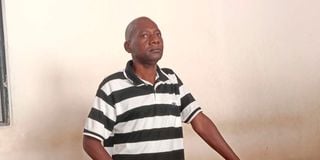Why the police are finding it hard to prosecute Mackenzie

Suspected cult leader Paul Mackenzie at the Malindi High Court.
On April 14 last year, police officers who had been covertly trailing the activities of Paul Mackenzie following his links to the murder of two children in Shakahola were informed that 10 more people had died in the forest after starving.
The revelations kicked off a probe that would cast a spotlight on religious cultism in the country. Mr Mackenzie was released on cash bail but, out of fear that his activities would soon be exposed, began living in secrecy, sending his followers to buy him food and other necessities.
This is until they exposed his activities in the forest, leading to his arrest and detention.
Nine months down the line, however, Mr Mackenzie is yet to take plea for any of the over 400 deaths that have been documented so far.
Despite multiple evidence from his surviving followers and testimonies by relatives of victims, detectives probing the case are still trying to link evidence collected from the crime scene to murder.
The Nation understands that items collected as evidence included exercise books, Sim cards, title deeds, clothes and burial paraphernalia, which provide key clues such as names of members of a family that was living in one of the 220 homesteads located in the vast 4,000-acre forest.
Also Read: 'How I survived Shakahola'
Chief Government Pathologist Johansen Oduor told the Nation all of the exhumed bodies could not be identified as they were badly decomposed .
Detectives discovered that, in a bid to aid faster decomposition of the bodies, the people conducting burial rites would wrap them in sheets or canvas.
Delays in prosecuting Mr Mackenzie and pressure from the public to have the case concluded saw senators tour the Directorate of Criminal Investigations (DCI) lab last October in search of answers.
To successfully prosecute murder, the investigating officer has to establish the suspect’s intent to commit the crime and link it to the action committed that led to the victim’s death.
According to a detective who cannot be named owing to the sensitivity of this matter, investigators probing the case explained that they had run out of key reagents for use in the DNA sequencing, and which are not available locally, therefore, none of the bodies had been marched by October.
Additionally, the fact that the DCI lab was not fully operational further hindered the probe.
Furthermore, orders from Director Criminal Investigations Mohamed Amin that evidence of the murder charge be proven beyond reasonable doubt to avoid the risk of presenting half-baked evidence or conducting shoddy investigations have seen detectives scouring the vast forest thoroughly, one homestead after the other, the officer said.
To tighten their evidence, they had to fetch the coordinates of each grave and homestead for use by the judge handling the murder case in the event the hearing of the case requires them to revisit the crime scene.
Detectives also established that most of the children ended up in the forest with their mothers and, in cases where fathers claimed to have lost their children to the cult, investigators have to trace the child’s roots through visits to their rural homes and with the help of the Children’s Department.
This explains why, last month, Assistant Director of Public Prosecutions Jami Yamina told a Shanzu court that, though 131 names of children suspected to have died have been found, they are yet to be matched with the bodies being preserved at the Malindi mortuary.
mwambui@ke.nationmedia.com


